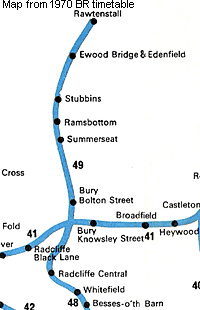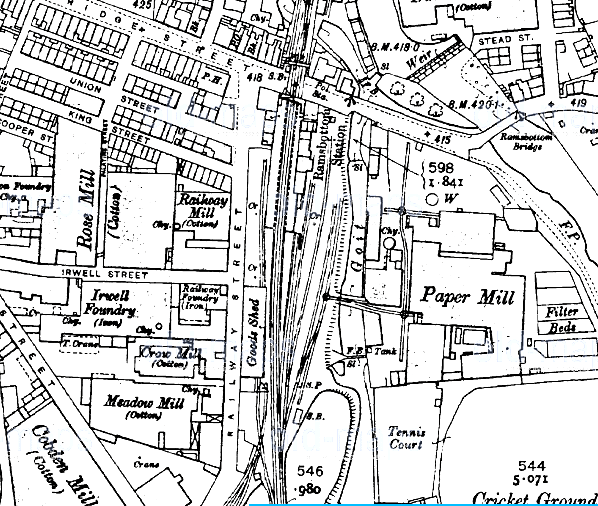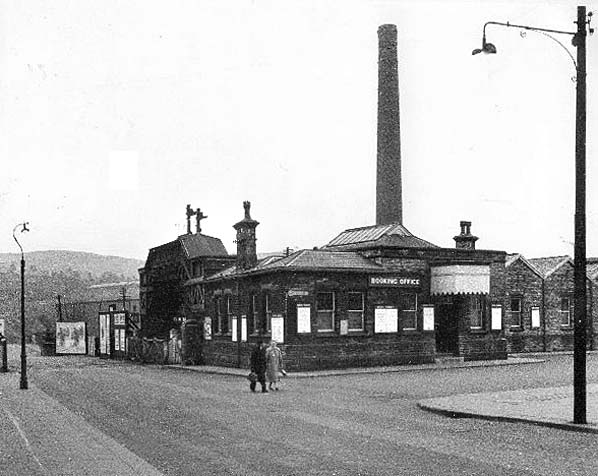Notes: Ramsbottom station was located on the East Lancashire Railway’s (ELR) Clifton Junction to Accrington line which had opened in stages between September 1846 and August 1848. At first the idea was for a line between Clifton Junction and Rawtenstall via Bury which was discussed at a meeting on 24th September 1843, the outcome being the creation of the Manchester, Bury & Rossendale Railway (MB&RR). This company was formally incorporated on 4th July 1844. While construction was under way another company, the Blackburn, Bury, Accrington & Colne Extension Railway (BBACER), proposed to build a line between Stubbins, which lay to the north of Ramsbottom, and Accrington. The aims of the two companies were so aligned that on 21st July 1845 the companies merged as the East Lancashire Railway.
 |
Ramsbottom station opened on 25th September 1846 when the line between Clifton Junction and Rawtenstall had been completed. The route at Ramsbottom was double-track so the station was provided with two platforms south of a level crossing which carried Bridge Street over the line. The main station building was west of the line on the northbound platform. A |
stone-built goods shed was also west of the line, adjacent to the northbound platform, but at its southern end with an 8-ton crane nearby. At the time of opening five passenger trains ran on weekdays in each direction between Manchester and Rawtenstall; there were four trains on Sundays.
At one time the station was shown as Ramsbottom Junction in timetables, because there were no platforms on the Accrington line at Stubbins, Ramsbottom was in fact the junction station.
On 17th August 1848 the ELR opened a route from Stubbins to Accrington. This created the main line from Clifton Junction to Accrington and reduced the Stubbins to Rawtenstall section to the status of a branch line which on 27th March 1848 was extended northwards to Waterfoot, and some four years later, on 1st October1852, to Bacup.
With the opening of the Accrington line Ramsbottom was also served by trains running between Colne and Manchester Victoria. By 1849 there were seven trains on weekdays to Colne, and six to Manchester which originated at Colne. There were four services that ran to Colne on Sundays and three to Manchester from Colne. Passengers from stations on the Bacup branch wanting to travel towards Accrington had to change trains at Ramsbottom thereby adding to its importance.
On 13th May 1859 the Lancashire & Yorkshire Railway (LYR) absorbed the ELR. Almost immediately they made improvements to the station, which included additional buildings. By the late 1850s the town of Ramsbottom had started to grow very quickly with many new factories opening, and it would continue to grow. The LYR started to use the route through Ramsbottom as an alternative to its congested main line between Manchester and Leeds which brought much extra traffic. The LYR also routed much of its holiday traffic through Ramsbottom.
 |
In 1875 the LYR opened a signal box on the north side of the level crossing, west of the line.
During the early years of LYR ownership all of the passenger train services from Ramsbottom had continued to run to Manchester via Clifton Junction but from1st September 1879 passenger services that had originated from the Bacup line were transferred south of Bury from the route via Clifton Junction to a new line via Prestwich. Accrington trains continued to run via Clifton Junction.
During the 1880s the LYR extended the goods facilities at Ramsbottom and made more alterations to the station. By 1882 there were fourteen northbound weekday trains to Colne and the same number to Manchester Victoria (originating at Colne) via Clifton Junction. Further alterations to the station in the 1890s included the construction of a covered footbridge at its northern end. By the end of the 19th century the station possessed single-storey stone buildings on the down platform which contained the main entrance, booking office, waiting rooms and staff facilities. A lengthy glazed canopy extended from the north end of the platform for half the length of the station. On the southbound platform there were single-storey brick and wooden buildings providing facilities for passengers and staff, and there was a canopy to complement that on the opposite platform. The station had a moderate sized goods yard with sidings on both side of the line running |
behind the two platforms. A signalbox on the up side to the south of the station controlled the sidings and goods yard with a second signalbox on the down side to the north of the level crossing. There was one private siding serving a bleaching works to the south of the station on the down side while a second private siding accessed by a turntable from the goods yard served the Ramsbottom Paper Mill to the east of the station.
In 1914 the LYR introduced a ‘Rail-motor’ service – known affectionately as ‘Little Billie’ - between Ramsbottom and Bacup; this called at all stations and supplemented trains that ran through to Manchester. From 11th April 1916 through passenger services to Manchester from the Bacup branch were diverted once more, this time to travel via Heywood, adding a considerable mileage to their journeys. The reason for the change was that from this date electric services began on the Bury to Manchester (via Prestwich) line. Passengers for Manchester travelling on these services were encouraged to change onto the electric trains at Bury for a quicker onward journey, and most of them did so.
Passengers travelling from Ramsbottom to Manchester had the choice of faster direct services that had originated from Colne and ran via Clifton Junction.
| On 1st January 1923 Ramsbottom became part of the London Midland & Scottish Railway (LMS). By summer 1932 the station had thirty-nine northbound services on weekdays; thirteen of them went to Colne, three to Accrington, one to Rose Grove, one went to Stubbins and the rest went to Bacup. There was also a service that arrived from Bury and terminated at |
 |
Ramsbottom at 5:50am. The first northbound service was for Stubbins, and it left Ramsbottom at 5:42 am. The last service which had originated from Bury Bolton Street left Ramsbottom for Bacup at 11:27 pm.
Thirty-eight trains travelled south from Ramsbottom on weekdays, five to Bury Bolton Street and four terminated at Bury Knowsley Street. Twenty-nine trains went to Manchester Victoria. Ten went via Heywood and nineteen took the more direct route via Clifton Junction. The first southbound departure was for Bury Bolton Street at 5:44 am. The last was also for Bury Bolton Street, and it left at 10.37 pm.
In 1938 the LYR signal box was replaced with a new one of LMS design, located on exactly the same spot as the original.
On 1st January 1948 Ramsbottom became part of the nationalised British Railways (London Midland Region). In 1954 the line between Bury and Bacup was considered busy enough to warrant the introduction of modern rolling stock, and it was reported in the local press that new diesel multiple units (DMUs) were to be introduced; they entered service on the line in February 1956. Ramsbottom had thirty-five trains in each direction between Bury and Bacup and thirteen in each direction between Colne and Manchester Victoria, giving a half-hourly service: the most intensive that the line would see.

|
The purpose of The reshaping of British Railways (Beeching Report) of March 1963 was to create an economically viable network, involving the closure of many loss-making passenger lines and stations. The report’s proposals for Lancashire and north Manchester were astonishing. The entire route from Manchester via Bury Bolton Street to Bacup and |
Accrington was earmarked for closure, yet the nearby Manchester – Oldham – Rochdale and the Bolton – Bury Knowsley Street – Rochdale lines were not. Services to Colne were rationalised and cut back to Accrington. The absurdity of withdrawing passenger services on the heavily used, electrified service between Manchester and Bury was acknowledged when, on 8th February 1965, the Minister of Transport refused consent to closure. However on 14th September 1966 the Minister gave permission for the Rawtenstall to Bacup and Bury to Accrington lines to close, which they did on 5th December 1966. Thereafter northbound trains from Ramsbottom terminated at Rawtenstall. Goods services were withdrawn on 30th April 1966. The train service became a shuttle between Bury Bolton Street and Rawtenstall, and from 4th March 1968 all stations north of Bury became unmanned. The March 1967 timetable showed fifteen services in each direction at irregular intervals, and two extra workings on Saturdays, one in the early afternoon and another late at night. No trains ran on Sundays.
With effect from19th April 1970 the line through Ramsbottom became a single track branch. The southbound line through the station was lifted, and the northbound platform became bi-directional. In December 1969 the goods shed were demolished and a year later the station buildings and footbridge were also demolished and replaced by a simple ‘bus shelter’ was erected on the former northbound platform.
 |
In the final year’s timetable from May 1971 weekday services had been reduced to twelve in each direction, with thirteen on Saturdays, the late night Saturday working having ceased by May 1970. The last passenger train service from Ramsbottom departed for Bury at 09:15pm on Saturday 3rd June 1972. The station closed with effect from the 5th June 1972. Some time after closure the former southbound platform, which had been out of use since 1970, was demolished.
Freight trains serving a coal depot at Rawtenstall continued to pass through Ramsbottom until 1980. To mark the end of the coal services, on 14 February 1981 a railtour, The Rossendale Flyer, ran up to Rawtenstall and then back again. The line was then officially closed. However a year later, on 28th March 1982, a railtour passed through once again. This was The Rossendale Phoenix, organised by a preservation group named the East Lancashire Railway (ELR) after the original |
company. They had entered into negotiations with British Rail with a view to reopening the line from Bury to Rawtenstall. Supported by the local authorities, they were successful and opened the stretch of line from Bury to Ramsbottom on 25th July 1987.
The ‘new’ ELR rebuilt the station at Ramsbottom. The former southbound platform was reconstructed, and a building in the style of the original ELR was erected on the northbound platform on the location of the original main entrance building. Over the years improvements continued to be made including the addition of a canopy and a footbridge. LMS-style gas lamp standards bearing reproduction maroon BR (LMR) totems lend an authentic 1950s atmosphere to this most attractive station.
On 27th April 1991 trains started to run northwards to Rawtenstall. Today the ELR is a thriving heritage railway, and Ramsbottom is one of its busiest stations.
Tickets from Michael Stewart , route map drawn by Alan Young, timetables from Alan Young
Click here to see of film of a train journey between Bury and Bacup in 1966
See also the Ramsbottom Model Railway Club web site which features 106 old photographs of the East Lancashire Railway and photographs of the clubs excellent layout of Ramsbottom & Stubbins.
Sources:
To see other stations on the East Lancashire Railway Clifton Junction - Bacup line click on the station name on the station name:
Clifton Junction, Molyneux Brow, Ringley Road, Radcliffe Bridge, Withens Lane, Bury Bolton Street, Summerseat, Helmshore, Haslingden, Baxenden & Accrington
See also Stubbins Junction to Bacup: Stubbins, Irwell Vale (new station on the ELR), Ewood Bridge & Edenfield, Rawtenstall, Clough Fold, Waterfoot for Newchurch, Stacksteads & Bacup
|

old6.jpg)


old8.jpg)

old10.jpg)
old1.jpg)
4.jpg)
1.jpg)
22.jpg) Ramsbottom station looking north in August 1987, a few weeks after the station was reopened. Note the temporary booking office on the left. At this time the up platform had not been rebuilt.
Ramsbottom station looking north in August 1987, a few weeks after the station was reopened. Note the temporary booking office on the left. At this time the up platform had not been rebuilt.23.jpg)
10.jpg)
18.jpg)



.gif)




 Home Page
Home Page